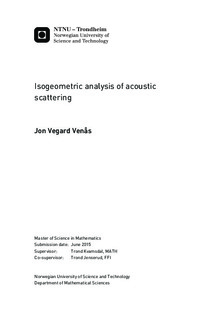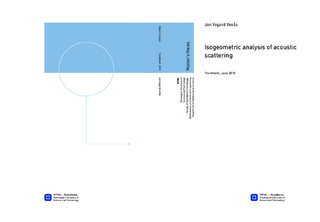| dc.description.abstract | Acoustic scattering has been thoroughly analyzed with the use of finite element analysis (FEA). The problem at hand is a coupled fluid-structure interaction problem on an unbounded domain, where an object of elastic material is surrounded by fluid. Using physical assumptions, the fluid is described by the wave equation which is transformed to the Helmholtz equation. That is, the frequency domain is considered instead of the time domain. In particular one is interested in the scattered pressure of a plane wave at a far field point. The far field is computed by first computing the near field of the fluid surrounding the object, and integrating this solution together with Green's function to compute the scattered pressure at a far field point. This results in the so-called target strength (TS) of an object. This is done for a series of frequencies in the lower spectrum, such that the TS may be plotted over the frequency spectrum. It will also be possible to plot the TS for a range of different incident plane waves, in addition to measuring the TS for a range of angles around the scatterer. As the domain is unbounded, one must create an artificial boundary in order to use FEA. There exist several methods for ensuring that the outgoing waves are not reflected at this artificial boundary, including the PML method after Bérenger, several absorbing boundary condition operators (ABC-operators) after Enquist and Majda (among others), the use of Dirichlet-to-Neumann (DtN) operators and finally the use of so-called infinite elements. A complete presentation of this analysis of acoustic scattering with the use of infinite elements has been presented by Frank Ihlenburg. The same analysis using isogeometric analysis (IGA), will be presented. An overview of IGA alongside the physical equations will be presented for completeness. A complete program will be developed in MATLAB, and GLview Inova will be used as a supplementary program for post processing.
The elastic object at hand is exactly represented by NURBS, and is thus especially suited for IGA. Moreover, it has been shown that IGA is superior to the FEA when considering spectrum analysis.
An extensive analysis of the spherical shell, where the 3D solution is known, will be presented. First, the eigenvalues for the elastic spherical shell is computed, then the acoustic scattering on a rigid sphere is analyzed and finally the full problem is analyzed where acoustic scattering of an elastic spherical shell is considered. All of this is computed using IGA and compared to the known analytic solutions.
The workshop Benchmark Target Strength Simulation (BeTSSi) has been a forum for the problem at hand, where several benchmark object has been analyzed by FEA and other methods. The complexity of these objects varies all the way up to a full submarine including torpedoes. Common for all objects is that no analytic solutions are found. Comparisons using several methods have been presented in the BeTSSi conference, with deviating results. The resulting TS graphs from IGA will be compared to existing methods. | |

